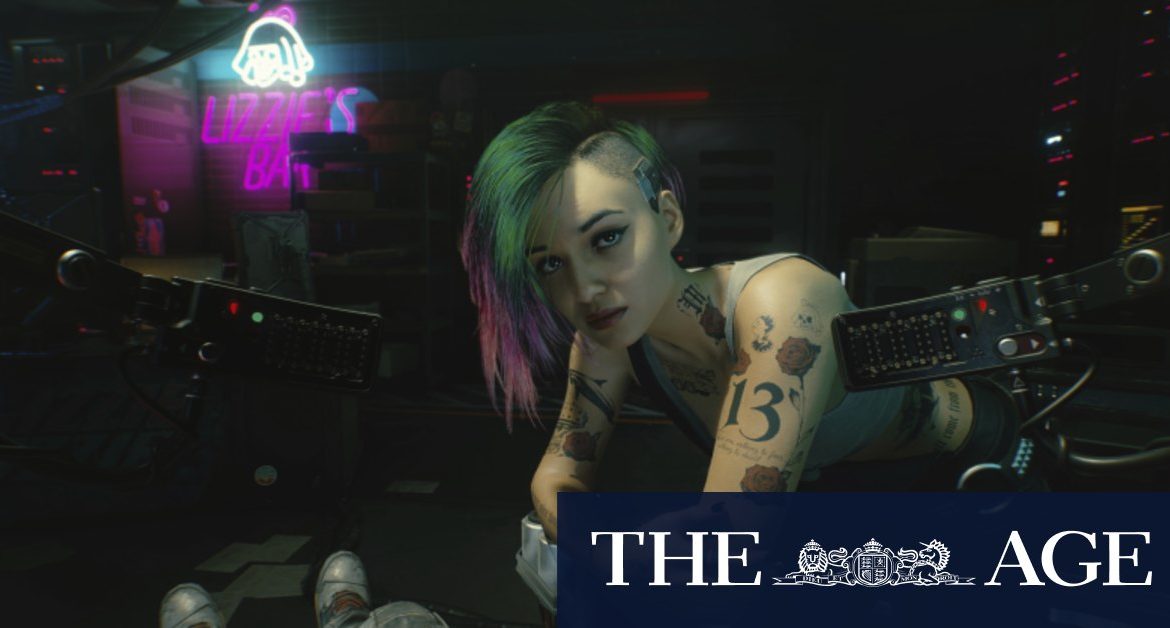It was reportedly a similar story for the PlayStation 4 version; fine on PS5, okay on PS4 Pro, abysmal on the base PS4. But on Friday Sony announced it was pulling the PlayStation 4 version of the game from its digital store, until further notice.
It’s all a real shame, because the technical and artistic work of hundreds of developers is palpable here, and results in a consistently compelling experience. I’d love to be telling you the biggest problems are the semi-frequent glitches I encountered (from characters forgetting to animate to gravity forgetting to affect cars), or the arguably problematic representations of race and sexuality. But all that nuanced discussion is useless if few people are able to actually play the game.
If and when you can play it (the publisher says fixes are coming), the first thing you’ll do is craft your ideal version of mercenary protagonist V in the impressively detailed character creator, before you’re thrown into one of three brief prologues depending on your chosen background, and a lengthy tutorial mission. For me, it was five-and-a-half hours before I saw the opening title card and was given free run of the massive Night City and its desert surrounds.
Combat can be fast and furious, with hammers and shotguns blasting through the scenery, or you can hide out and hack enemies from afar.
I loved the aesthetic diversity of the city, which goes beyond discretely themed zones to blend shiny new skycrapers with grubby arcades and markets. It’s a place with an evident and inescapable history and a clear class divide rather than a homegenous future-ness, and you feel that from the weapons you pick up and the places you visit to the cars you drive and the optional backstory articles you read.
V’s primary objective revolves around a mysterious chip inserted in his head, which contains the technological ghost of dead rocker Johnny Silverhand (played by Keanu Reeves), which threatens to take over his body and wipe out his own mind.
But while the critical path is all corporate intrigue and transhuman immortality, the best bits of story are found organically as you explore, with more and more new missions unlocked as you make friends and enemies across the city. I tracked down missing taxis that had wandered off due to a depressed AI, fist-fought my way to the top of an underground fight club and explored the edges of the desert and the bottom of the sea as part of huge multi-layered heists. The way your actions and decisions can dynamically affect later missions and lead you down rabbit holes is truly impressive, even if it can be hard to keep track of.

Complicated heists make up some of the longest and most story-heavy missions.
And though much of the gameplay is first-person (you can shift the camera behind you while driving), and combat is primarily gun-based, this is an RPG through and through; your options for both fighting and getting around are dependent on your ability levels, the perks you’ve chose along the way, and the gear you’ve uncovered or crafted.
Physically strong characters might be able to smash through doors to get to their target quicker for example, while others might be sneaky or get combat buffs with every kill. Some of the systems do feel superfluous or ill-explained at first but, especially once I’d played for a while and started again as a new character, I felt there was a lot of versatility in building out a distinct V.
Storytelling and atmosphere are undoubtedly the game’s main strength, with strong acting performances from both the male and female V and many of the supporting characters (Reeves is comparatively pretty dull), but it’s not a home run.

You can always steal a car to get around, but if you save up some cash you can buy wheels of your own that you can summon from your phone.
There’s a bizarre tendency towards the juvenile for example, from the ability to choose a penis size in the character creator (with no impact on the game whatsoever), to extreme gore for its own sake, and from some really goofy dialogue to the pointless softcore porn triggered when you hire a prostitute. Then there’s the aforementioned depictions of race and sexuality, from the commodification of trans people to a stereotypically occult Haitian gang. You could argue these representations are all meant to speak to how dark and broken the world is, but they’re mostly presented without argument or even humour. They’re just there.
I was also surprised that while the game nails the edgy cyberpunk aesthetic, from the oppressive corporate advertising to characters with their entire faces jaggedly torn out and replaced with tech, the theme is squandered in most every other way. You can go to a doctor to upgrade many of your internal parts, but your outward appearance is bizarrely locked and can’t be changed. For all the transhumanism, your options in roleplaying haven’t progressed beyond other games in the genre, save for the ability to remotely hack stuff.
But for the most part I was able to totally ignore those shortcomings and the standard weirdness of video game rules existing in a realistic open world (cops will chase you for bumping their car but throwing a grenade into a market generally comes with no repercussions), thanks to the constant succession of intriguing road trips, investigations and diversions.

Many characters have extensive robotic augmentations, but unfortunately your own options are limited.
With a near-peerlessly rendered world and a gleefully oppressive atmosphere, Cyberpunk 2077 only gets better the deeper you get into its character customisation and bottomless pit of storytelling, despite some thematic missteps and immature moments. It could have made for an exciting end to the year and the console generation, but instead one can’t help but feel it should have been held over to the next.
Cyberpunk 2077 is out now for PC (reviewed) and Xbox One, with PlayStation 4′s return TBA.
Technology newsletter
The top technology stories, gadget releases and gaming reviews delivered every Friday. Sign up here.
Tim is the editor of The Age and Sydney Morning Herald technology sections.
Most Viewed in Technology
Loading







